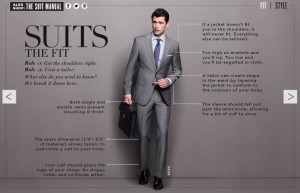There are really two questions here:
- Why would anybody be interested in men’s suits? and
- Why am I specifically interested in men’s suits?
The first question is easier for me to talk about. Men’s suits are interesting. The history of tailoring and the art of fitting the body. Greater transitions in expressions of masculinity from silk jackets and lacy cuffs to wool trousers and silk neckties. The male sartorial instinct for urban camouflage over standing out.
But why am I specifically interested in men’s suits? It’s not a simple answer, and to be honest I’m still figuring it out myself.
First of all, my interest in this as a field to focus on started when I was a costume designer. There were always so many books for any given period on women’s dress, but men’s suits would be summed up in just a chapter, or even a paragraph. They would say things like “because menswear didn’t change as rapidly or dramatically, it was the details that became so important,” but it would never tell you what those details were. So, initially it was just filling a hole. Research didn’t exist when I needed it, so I wanted to find it.
But the more I focus on menswear, the more I find how personal the connection is. Not for the suits themselves, but for the meanings and implications behind them. I grew up in a small hippie beach town in California, where to be ‘dressed up’ meant you wore a Hawaiian shirt and new flip flops. My dad wore a suit to work every day, but he didn’t particularly seem to enjoy it, and the second he retired he donated every last one of them to Goodwill. All I remember about his wearing suits was the smell of shoe polish, and ties and coats hanging over the back of chairs in the dining room as soon as he got home.
For a while before, during, and after college, I worked as a carpenter for some theatrical scene shops and as a work-study job on my college campus. I eventually became mostly a welder, but I also built platforms and painted houses and tore down walls and framed doors and hung drywall and you wouldn’t think that those things were fun, but I loved it. I loved being strong and getting dirty and building stuff and feeling such a huge sense of accomplishment at the end of the day. It wasn’t a sustainable life, and I moved on to other things, but I enjoyed it a lot while it lasted. One of the things that made that kind of life so rewarding was the lack of emphasis on how I looked. I wore the same few pairs of Carhartts and work boots baseball hat and just another clean black t-shirt every day, and I barely had to look in the mirror before I left for work.
In contrast, working as a costume designer in New York City, getting dressed in the mornings was totally stressful. Making a choice about what to wear every day wasn’t just about which pants/top/shoes/jewelry/hairstyle to wear, but about who I wanted to be that day, how I wanted the world to see me. I missed the careless practicality of wearing the same thing every day. Sure, part of the difference was the type of work that I was doing, but it made me more and more aware of gendered approaches to clothing.
Some men hate wearing suits. Maybe they feel too formal, too old-fashioned, or maybe they don’t like that they have to look just like everyone else. I was envious of suit-wearers. No pantyhose, no heeled shoes. No need for a diet to fit into skinny low-rise jeans. No daily conflict between loose-on-top-and-skinny-on-the-bottom-or-vice-versa? No clashes between various types of collared shirts/sweaters/coats. All the elements in your closet work together, with possible exceptions of color or pattern. Dressing takes less effort.
It is that practicality which is inherent in a uniform which is so appealing to me. It suggests that you’re here to get a job done. No decision burnout before you leave the house, no emphasis on how cute you are, no physical discomfort, and you’ll get noticed for the things you say and the work you accomplish rather than your new skirt.
